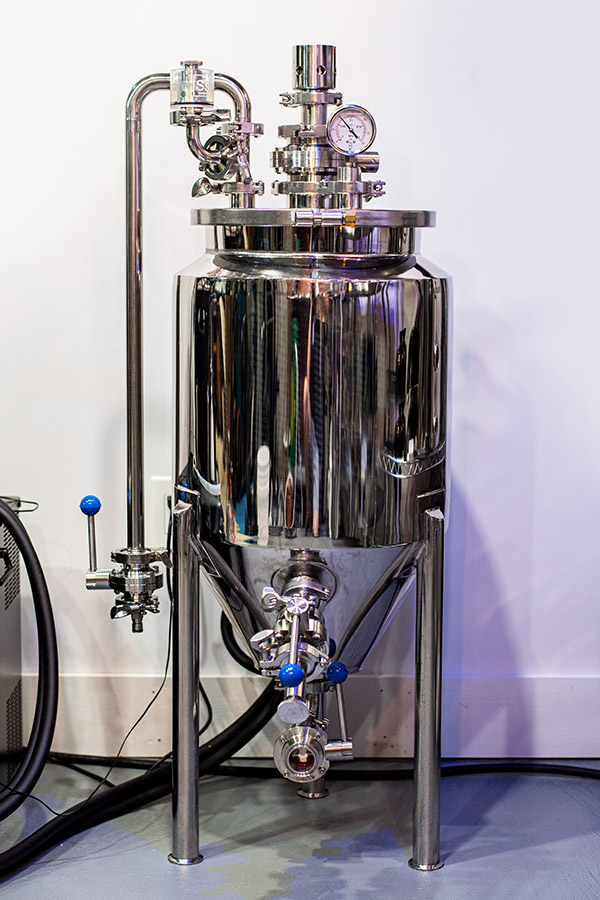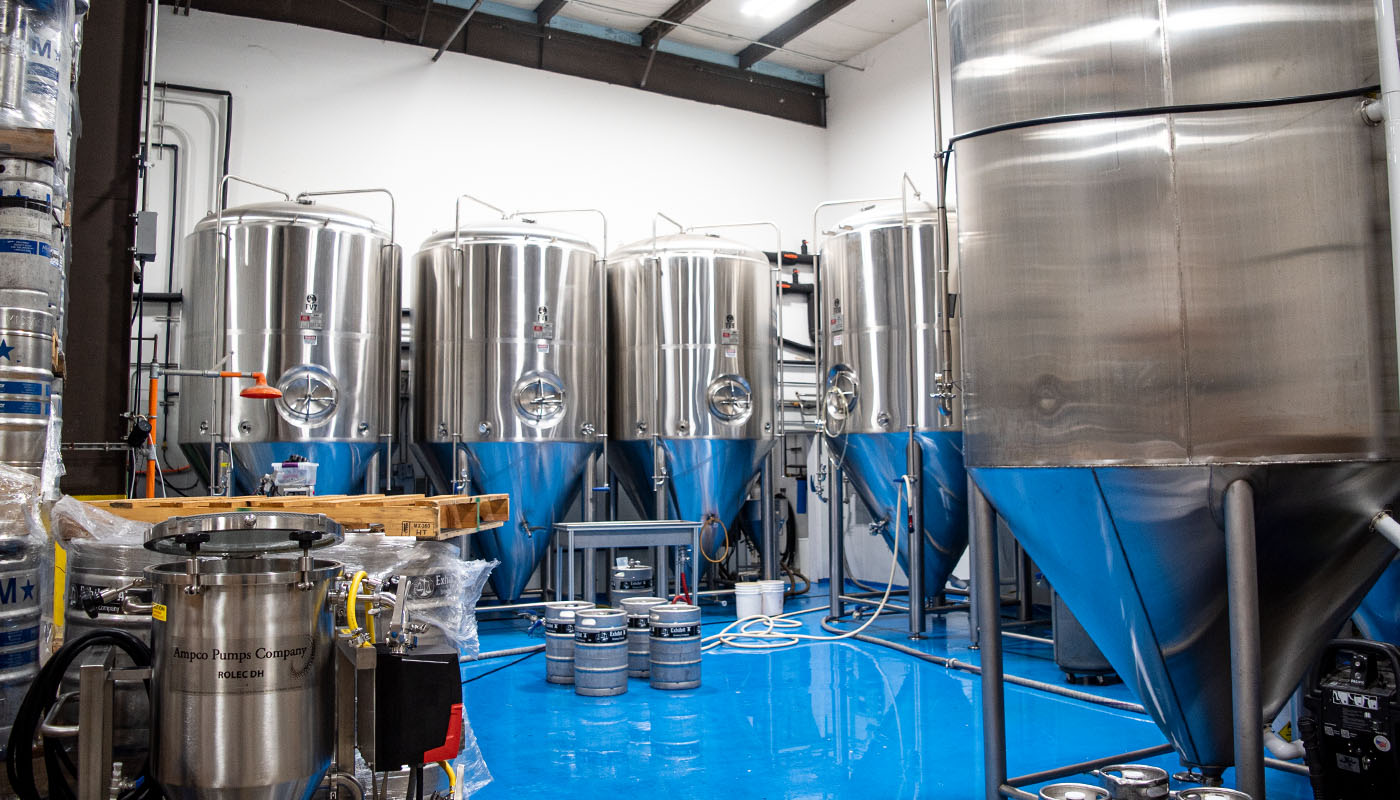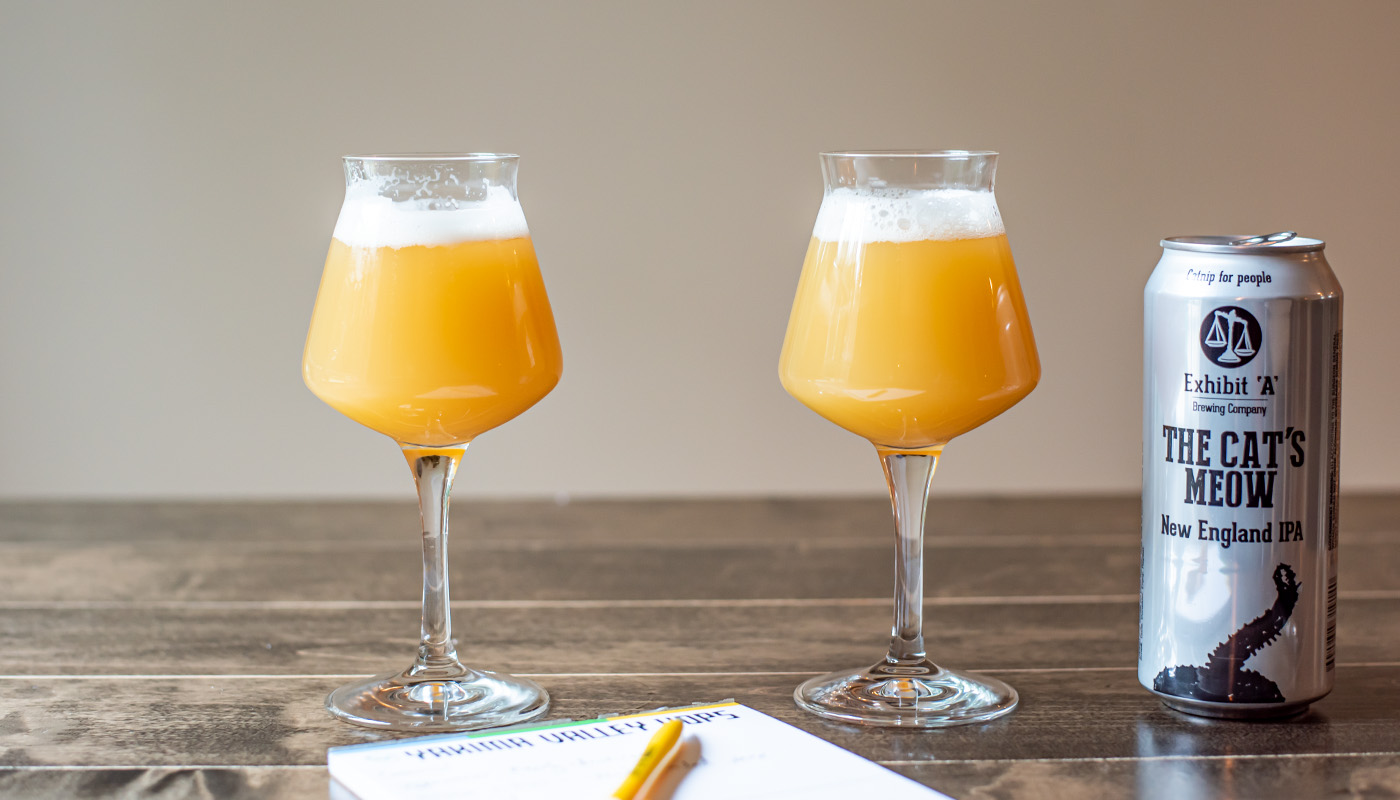One thing that’s been at the very top of my homebrewing wishlist is to brew a true commercial clone of a New England IPA. Why? I want to compare the same beer brewed on the commercial scale vs the homebrew scale. I would recommend you read this post as a prelude before going any further.
This type of experiment is easier said than done. In today’s world of craft beer, it’s more difficult to find local breweries with true flagship beers. This is even more difficult when it comes to New England IPAs. Many breweries constantly rotate out new beers every few weeks and only occasionally revisit fan favorites.
In order to truly evaluate a side-by-side comparison, I needed to brew a beer I could go out and readily purchase at any time. Waiting several months for a beer to roll around again is simply not an option when it comes to IPAs. Freshness holds a huge impact on characteristics. After reaching out to a few local breweries, Matthew Steinberg, co-founder and head brewer at Exhibit ‘A‘ graciously answered the call.
The Beer & Brewery

Exhibit ‘A’ is located in Framingham, Massachusetts, just 25 minutes away from where I live. Exhibit ‘A’ produces a wide range of beers with an emphasis on New England Style IPAs. Their most popular beer (and a long-time personal fav) is a New England IPA by the name of Cat’s Meow. Cat’s Meow pours a nice golden hazy orange and reveals a bouquet of tropical and citrusy orange notes. I love it because it strikes the perfect balance of being a characteristically juicy IPA while still being a more standard ABV beer at 6.5% (by today’s standards, at least).
Exhibit ‘A’ sources a lot of locally grown grains from Valley Malt in Massachusetts. Matthew talked about the importance of being able to go to the farm, touch the soil, talk with the malsters, and find the perfect fit for their brewery. This is something I would personally love to do as a homebrewer—I really appreciate the aspect of supporting local businesses and agriculture. To my surprise, Exhibit ‘A’ distributes their beer as far as Japan! In fact, Cat’s Meow is in high demand over there…I can’t blame them.
The Purpose
Cloning commercial beer seems to be a hot topic in the homebrewing world. While some homebrewers love to try to replicate commercial beers, others see it as a ‘complete waste of time and lack of creativity‘ (if this describes you, the following will deeply disturb you). I personally view cloning as a huge opportunity to learn and understand the difference between professional and amateur brewing practices.
The purpose of this experiment was three-fold. I wanted to evaluate the feasibility of truly replicating a commercial beer with as many controlled variables as possible. Can larger commercial recipes simply be scaled down and easily brewed at the homebrew scale?
The other facet of this experiment was centered around understanding the ingredients and output of a particular recipe. It’s difficult to evaluate our own recipes when we don’t have anything to actually compare them to. I thought this would be a great opportunity to grade myself and really test my brewing chops as it came to brewing New England IPAs.
Lastly, there’s a lot of speculation and misinformation out there when it comes to comparing commercial and homebrewed NEIPAs. Do commercial breweries need fewer quantities of adjuncts to achieve the same level of haze? Do homebrewers need more hot side hops to replicate the same level of bitterness and saturation? What variance in dry hopping is needed to achieve the same level of juicy hop character? I was able to get to the bottom of all of these questions with this experiment.
My Equipment
I think it’s important to start by prefacing the equipment I’m working with at home. I brew on a 20-gallon electric eBIAB setup with a 5500-watt ripple element. My fermenting vessel is an 8 gallon jacketed Brewers Hardware Unitank with every bell and whistle a homebrewer could possibly ask for.
While my hot side process is simplified, my cold side process is basically just as sophisticated as any commercial-sized conical. This obviously makes replicating the commercial process that much easier and gives me a massive advantage over your typical entry-level setup. I honestly don’t think I could possibly achieve the same result in a plastic bucket or glass carboy.

Recipe Scaling and Process
Matthew and I spoke at length about the process behind brewing Cat’s Meow. I was really focused on trying to replicate every possible variable on the homebrew scale. I’m going to break down the various parts and touch on the highlights.

In terms of scaling the actual recipe, I took a pretty basic approach. Brewing software is essential when it comes to doing this sort of thing. This allows you to define and scale grain percentages, estimate original and final gravity, and calculate estimated IBUs. In terms of bittering additions, this is the route I went.
Grain Bill: This was the easiest part (sort of). The grain bill was a matter of scaling down the supplied grist percentages to a 5-gallon batch. Exhibit ‘A’ sources a few particular local grains I didn’t get around to picking up. While I could get these in the future if I really wanted to, I used the closest replacements I could find online. The grist was pretty standard and comprised of 2-row, wheat, flaked oats, carapils, and acidulated malt.
Yeast: I brewed with the same brand/strain used in Cat’s Meow. Lucky for me it’s very popular and available to homebrewers. And for everything thinking, DUH, it’s WY1318…it’s not. The only aspect I was not really able to replicate here was yeast generation. Cat’s Meow isn’t typically brewed with a fresh pitch. Matthew finds the character to be too clean and lacking the necessary fruity esters as seen in later generations.
Since I did not have a previous generation of my strain, I made an oversized yeast starter and let it completely finish fermenting. While this isn’t a purrfect approach, it’s probably pretty close. I actually ended up pitching a really healthy count of yeast. It was likely slightly overpitched for the batch.
Hops: I think it’s important to understand that not all hops are created equal. Just like wine grapes, hops change from year to year and express different characteristics depending on the lot and region. It’s not uncommon for breweries to be brewing with hops that are 2-3 years old. While I was able to replicate the hop varieties for this beer, I’m not *actually* using the exact same hops. This beer was brewed mainly with Citra, Mosaic, El Dorado.
The whirlpool and dry hop additions were simply converted from pounds per barrel to ounces per gallon. The hot side additions were pretty modest and fell a little lower than my typical hot side additions (1.75 oz total). The dry hop translated to a 7-ounce charge consisting of 3 different hop varieties.
Water: Geographically speaking, Exhibit ‘A’ and I are likely getting water from the exact same source. I used my tap water and built up the same water profile for Cat’s Meow. This beer features your typical 2-1 chloride to sulfate ratio.
Whirlpooling: This was one step of the process that was the most interesting. Exhibit ‘A’ leverages a separate whirlpooling vessel that is strictly used for the purpose of whirlpooling hops. Hot wort is pumped directly from the boil kettle and converges with hops at near knockout temps in the whirlpool tank. The wort is NOT run through a heat exchanger, therefore their whirlpool is on the hotter side than what I typically do at the homebrew scale.
I think it’s important to note that this may actually be the norm for a lot of commercial breweries. Running hundreds of gallons of hot wort through a heat exchanger to slightly drop the temp is not always functional. Furthermore, the actual whirlpool duration is about 90 minutes before the wort is ultimately cooled down to pitching temps. This is dictated by several factors related to the sheer scale of the entire operation. Commercial breweries can’t chill an entire batch down in 5 minutes like homebrewers.
To account for all of this, I ran a 90-minute whirlpool starting at around 195°F. I turned off my heating element, covered my kettle, and let the temp naturally drop over 90 minutes before passing through my counterflow chiller and into my fermenter.
Cat’s Meow is brewed on a 21-day schedule. The beer is dry-hopped at terminal (day 5-6), cold crashed for 48 hours at 32°F, carbonated in a brite tank, and left to condition in the cans before distribution. I basically followed their schedule to a T. Rather than transferring to a brite tank to carbonate, I kegged my beer via closed transfer and forced carbonated over the course of a week in my keezer.

Everything went really smoothly in terms of the brew day with the exception of ONE piece. My beer ended up over attenuating and finished 4 points drier than the commercial example. My beer finished at 1.012, while Cat’s Meow typically finishes closer to 1.016. While I was initially disappointed, it turned out to be a very small difference. I later realize I mashed about 2 degrees lower than I thought. This was likely due to temp loss from mash recirculation on my new system.
The Tasting

Luckily the timeline for this tasting happened to work out really well. I dropped off some beers at the brewery for Matthew’s notes and picked up ultra-fresh cans of Cat’s Meow. Based on the date stamped on the bottom of the cans, these beers were likely brewed in the same week or in a matter of days from each other.
The picture above shows my beer on the left and the commercial beer on the right. Haze, appearance, carbonation, head retention were all nearly identical. The aroma between the two was also very similar. I thought I may have perceived a greater rush of tropical notes from the commercial beer but it was very very close.
Upon tasting these beers side by side for the first time, I was actually blown away by how similar they tasted. Despite my bias that the commercial beer would be better, I initially had a hard time detecting any major differences. After several back-and-forth sips, I could only pick up on a few minor subtleties between the two samples.
I think the biggest difference between the two beers was the overall roundness. The commercial beer felt a little fuller and likely benefited from finishing a few gravity points higher. This is something that is easily correctable on my part and not something I’m really worried about.
I thought my beer may have been a little more bitter. This could have been a result of extended whirlpooling or related to my final gravity coming in lower. A sweeter beer would likely mask some of the bitterness in the same IBU beer.
I thought my beer may have had a bit more vegetal character than the commercial beer. This was difficult to pinpoint, to be honest. If you gave me each of these samples blind, I would have had to honestly guess which was mine and which was the commercial beer. I was pleasantly surprised I was able to come pretty close to the real thing on my first try.
While I did not conduct this experiment blind (I should have), I think I would have had a difficult time guessing which beer was in fact mine. I had friends and family try each sample blind over the next few weeks and had pretty consistent reactions. Most samplers initially thought the two beers tasted exactly the same. People had to go back and forth between the two beers to notice the subtitles. I don’t have a tally in terms of preference, but tasters were mixed in guessing which was mine and which was the commercial beer.
I’m still waiting on feedback from the brewers at Exhibit ‘A’ but I’m hoping to update this very soon.
Final Thoughts
Overall, I thought this was a successful experiment. I’m convinced that beers can be reasonably cloned assuming you have the right ingredients, equipment, and processes. Outside of the few minor differences, I probably couldn’t have gotten much closer UNLESS I used the exact same ingredients, especially hops.
Matthew talked about some of the stunning qualities of the El Dorado hops he had on hand. He also talked at length about how commercial shops choose and evaluate hops for their brewery. They have a dedicated process when evaluating specific qualities in hops. While I used my own El Dorado stock, there could be subtle differences between the two that deliver different results in beer. If I wanted to get overly technical, I’d have to brew with Exhibit ‘A’s ingredients to get the same subtle nuances and general character.
With that in mind, could a flagship beer using the same recipe/ingredients be better/different over the course of several years? Absolultly.
Cloning is very interesting because the little DETAILS really matter. It’s the small things such as ingredient choice, temperature, and water treatment that start to present themselves when really analyzing a beer. For the purposes of this experiment, I think I was able to get close enough to satisfy my own curiosity. While I’d love to make some tweaks and brew it again, I’m confident in my own ability to brew a commercial quality beer at home.





Are you going to be posting your clone recipe sometime in the future? I love Exhibit A, and would like to try this out myself.
Great question @Chris!
I would love to try this. TCM is my favorite NEIPA by far. I’m curious to see your clone-recipe so I can try it out and also merge it w/ the Treehouse Julius clone on BrewFather.
I would love to share…but I don’t have permission at the moment.
Very high quality post! Are you going to leave us guessing on those details? What’s the yeast?
Would like to hear what the brewers thought! Cool experiment and am impressed with your results.
I ended up having Cat’s Meow 2 nights ago (friend brought back a 4-pk from the brewery last weekend). It was tasty (drank right from the can). As I got closer to the bottom, I was getting more vegetal notes from the hops. Overall a very solid beer!